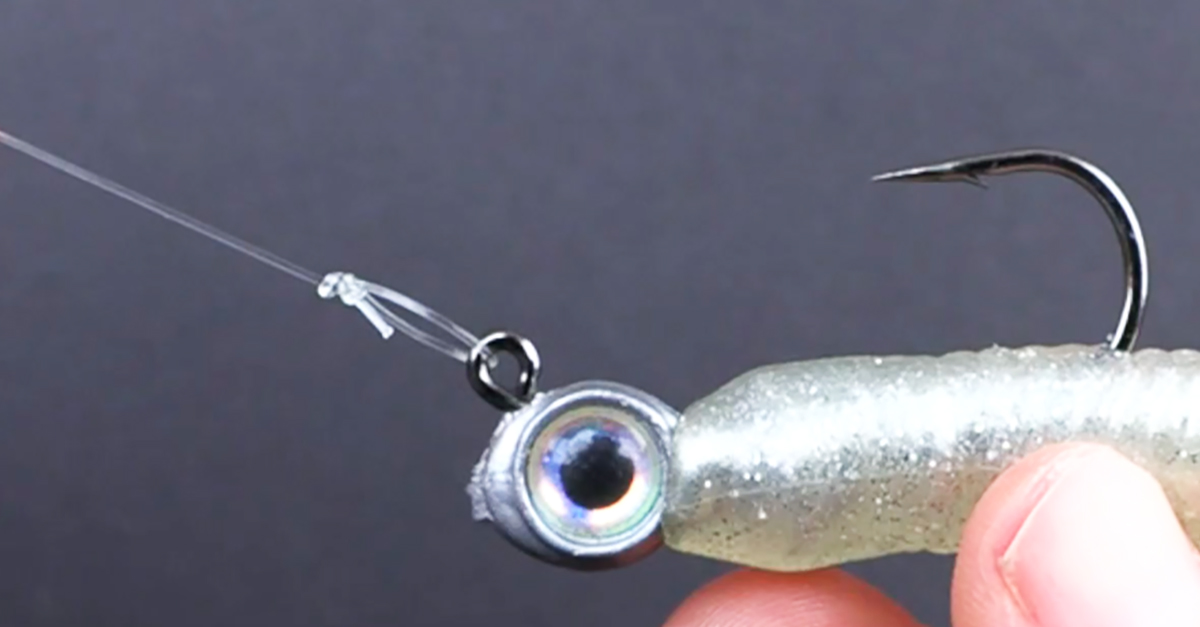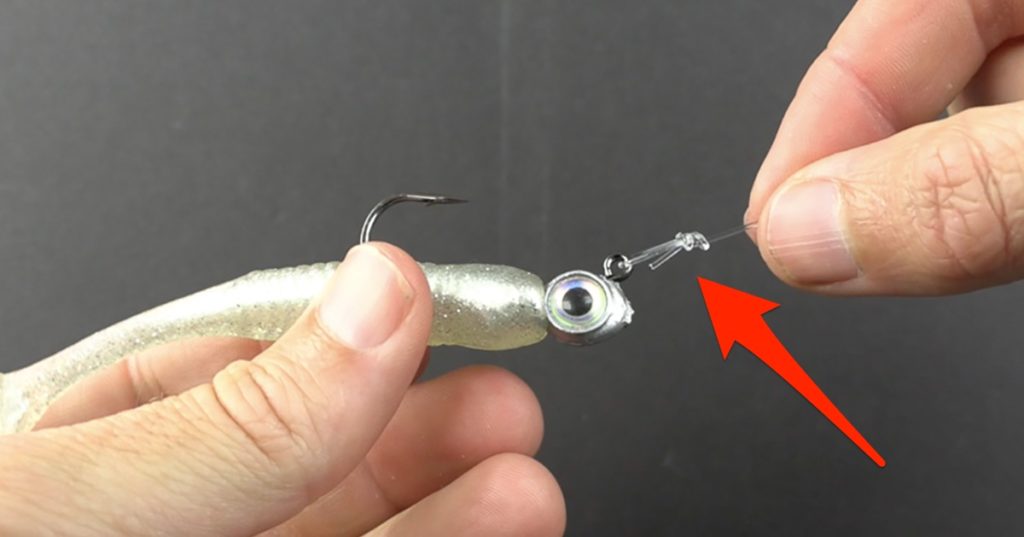Non-Slip Loop Knot: How Many Turns Should You Do? [Knot Experiment]
- By: Luke Simonds
- on

If you maximize a lure’s action, you’ll maximize the strikes you can get with it it.
This is why it’s best to use a loop knot when using a lure you need to put action on, like a soft plastic on a jig head or a topwater lure.
But here’s the bad thing about loop knots: they’re not as strong as snug knots.
Because of this, it’s important that you tie a strong loop knot.
My favorite loop knot is the non-slip loop knot and to make sure I’m getting the most out of it, I decided to test the optimal number of turns to make when tying it.
I tested two turns vs. three and four turns and the results were not what I was expecting!
Check out the experiment in the video below and see how many turns leaves you with the strongest knot.
Optimum Number Of Turns For A Non-Slip Loop Knot [VIDEO]

This experiment was done with 20 lb. Ande monofilament and, except for the number of turns, I followed the steps for how to tie the non-slip loop knot in this video.
Here are the results (measured in pounds of force it took to break the knot:
2 Turns:
Test #1: 21.59 lbs
Test #2: 20.22 lbs
Test #3: 19.75 lbs
Average: 20.50 lbs
3 Turns:
Test #1: 21.06 lbs
Test #2: 21.38 lbs
Test #3: 22.73 lbs
Average: 21.72 lbs
4 Turns:
Test #1: 19.15 lbs
Test #2: 19.38 lbs
Test #3: 19.54 lbs
Average: 19.35 lbs
Discussion
This was a little surprising!
There was an expected strength increase from two turns to three turns, but I did not expect a decrease between three turns and four turns.
It appears that there’s something about the extra turn that renders the knot weaker.
The good news about these tests is that they were all relatively consistent and there weren’t any outliers that would make me question the validity of these results.
Now although the knot with three turns is strongest, I will still be using the knot with two turns.
It makes for a cleaner knot (less visible to the fish and less opportunity to snag weeds) and, at over 20 lbs. of breaking strength, it’s stronger than the FG knot I’ll be tying at the line to leader connection.
I’m using with 10 lb. braid there, so I don’t need a knot much stronger than 20 lbs. of breaking strength.
Conclusion

As it turns out, there is a difference in strength between the number of turns you put in a non-slip loop knot.
Three turns yields an average of 21.72 pounds of breaking strength, two turns yields an average of 20.50 pounds of breaking strength, and, most surprisingly, four turns yields the weakest knot at an average of 19.35 pounds of breaking strength.
I’ll still be using the non-slip loop knot with two turns because it’s cleaner and I don’t need a knot that has more than 20 lbs. of breaking strength when my braided line is only ten pound test, but I’m glad to finally see these objective results.
Were these results what you expected?
Have any questions about the best way to tie the non-slip loop knot?
Let me know in the comments below.
You can learn how to tie the non-slip loop knot here.
And if you know someone who puts more than two turns in their non-slip loop knot please TAG or SHARE this with them!
P.S. Want access to our best fishing spots and tips, plus discounts to our online tackle store? Click here to join us in the Insider Club!
Related articles:
Related categories:
STOP WASTING TIME ON THE WATER!
Do what the “SMART ANGLERS” are doing and join the Insider Club.
Here’s what you’ll receive today when you join:
- Weekly fishing reports and TRENDS revealing exactly where you should fish ever trip
- Weekly “spot dissection” videos that walk you through all the best spots in your area
- Exclusive fishing tips from the PROS you can’t find anywhere else
- Everything you need to start catching fish more consistently (regardless if you fish out of a boat, kayak, or land).
STOP WASTING TIME ON THE WATER!
Do what the “SMART ANGLERS” are doing and join the Insider Club.
Here’s what you’ll receive today when you join:
- Weekly fishing reports and TRENDS revealing exactly where you should fish every trip
- Weekly “spot dissection” videos that walk you through all the best spots in your area
- Exclusive fishing tips from the PROS you can’t find anywhere else
- Everything you need to start catching fish more consistently (regardless if you fish out of a boat, kayak, or land).











I have used this non-slip loop knot for many years with a single twist, and yes, I’ve had failures at the loop knot on trout, jacks, blues, reds, tarpon and more…
Luke, have you done the same test for 30lb, 40lb and 60lb? The big question left unaddressed in my mind (and likely others), is does the 3 turn consistently outperform 2 and 4 turns in the heavier test lines? My guess is that the 60lb might perform better with less twists, maybe even a single twist?
Favorite top water lure for a loop knot – Yellow Zara Spook. It has more white/silver on the belly and has outperformed all the other colors I’ve tried. BTW, if anyone knows if this is still available new anywhere, feel free to share… Thanks!
Heddon/Original Zara Spook (XRY-Yellow Shore Minnow) 9250
Luke, would a barrel swivel with safety snap work like a non slip loop knot. Using a safety snap is faster and easier for me in a kayak (and some arthritis in some of my fingers doesn’t help either) ?
Yes, that will help the lure get good action in the water too.
Thank you, I just joined Salt Strong and learning a lot of good things, hopefully I can get out soon and catch some fish.
Luke, on your saliva/no saliva test the average for Ande Mono 20lb with a two twist loop knot was right around 17 lbs. For this test the two twist average is right around 20 lbs.
Do you think the difference was test setup? Just curious.
Luke, thanks for the use of science. Snags are a part of fishing. When I have to break a line, due to a snag, I don’t want to lose my whole rig. I would rather just lose the lure. Why don’t you use, say, 30lb braid with a 20lb leader and the loop knot tying on the lure. That way you have to break points before losing your whole rig. The break points should be first the lure, second the leader. The last thing I want to do while fishing is tying a FG knot.
My pleasure Gregory! I do sometimes use a 20 lb mainline, but only when I’m fishing for bigger fish near hard structure (mostly docks) so that I have the added pulling power.
Otherwise, I prefer to use the 10 lb mainline because it has much better casting and retrieving performance.
Consider testing with direct attachment to braid, no leader.
After seeing a difference in catching pinfish for bait (10 lb braid lost handily in catching pinfish to a 20 lb mono leader), I now always use a mono/fluoro leader.
Plus, mono is much more abrasion resistant which is very important when targeting fish with rough mouths (like snook, bass, etc). Here’s a test showing the abrasion difference: https://saltstrongdev.wpengine.com/articles/braid-vs-mono-abrasion-strength-experiment/
Like have you tried comparing the non-slip loop know to the canoe man loop knot. Would be interesting to see that. Canoe man is much faster to tie
I’ll make sure to test them out.
Have you tested flurocarbon leader
Yes, this loop knot works great for fluoro too (fluoro is actually a type of monofilament line, so most knots work equally well for them both… fluoro just typically has a lower breaking point due to it being more dense and less malleable)
I often throw lures on 10lb leader, so will stick with 3 turns for <20lb line until we see test results telling us otherwise. It’s great to have this information, since most descriptions of the Lefty Kreh knot outside of Salt Strong show 4 or 5 wraps. Even the tutorial here says 3 wraps for >40 and 4 wraps for <40lb.
Also curious what to use for 60lb loops for beach and offshore. There must be an alternative that doesn’t have such a sharp turn at the far end of the wraps? Maybe a king sling or something more “figure 8” ish? I suppose a bigger knot would be acceptable in that weight range.
I reference your “fishing-knots” article all the time. But would love to see some differentiation in those lists for heavy vs light light line.
Back to the lab for you!
I use this not for 60 lb line too… just do the two twist method and it gets the job done with 100+ lb tarpon.
The figure 8 knot is well known for tarpon too, but it takes longer to tie and didn’t test will with the lighter lines so I don’t bother using it.
Luke, your info is always great and your test clearly show the the results. I am interested though in just one turn on your machine? I have always only used one 1 wrap and back through and have never had an issue with a knot failing. (slipping out).
Good to know..thanks for providing test result
Thanks for making time to leave the nice comment Dave!